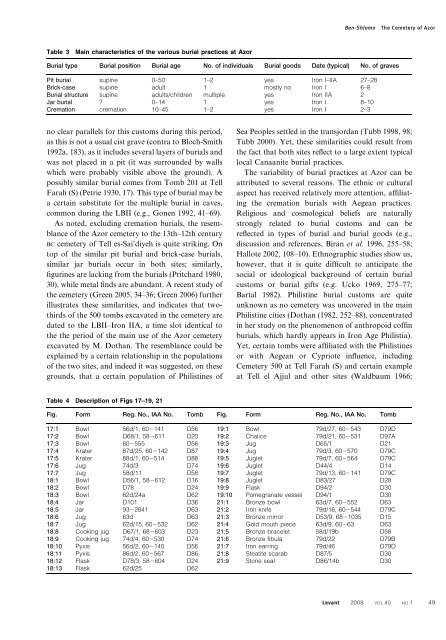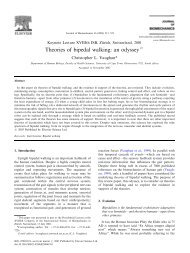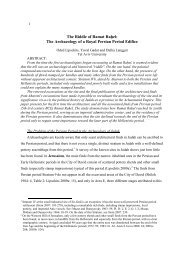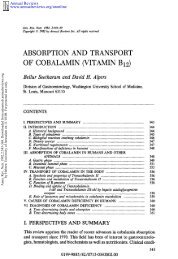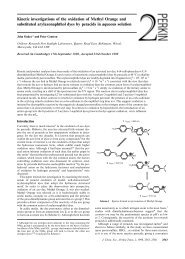Ben-Shlomo<strong>The</strong> <strong>Cemetery</strong> <strong>of</strong> <strong>Azor</strong>cemeteries. Notably are the jar/pithoi burials appearingalso at Zeror <strong>and</strong> dated to the LBII (Ohata 1970,71–74, pl. LVI), as well as regular pit burials dated tothe LBII/<strong>Iron</strong> I (Ohata 1970, 71, pl. LV) appearing inboth cemeteries. <strong>The</strong> cist graves with multiple burialsat Zeror (Ohata 1967, 36, pls XXXV–XLV; Ohata1970, pls LI–LIV), are somewhat similar to the burialstructures at <strong>Azor</strong>. Note, however, that the publishedevidence regarding the dating <strong>of</strong> the various tombs atZeror is rather limited. An <strong>Iron</strong> <strong>Age</strong> cemetery wasreported from Tell ‘Eitun (Dothan 1982, 29–33;Edelstein et al. 1971), but only a few tombs wereexcavated <strong>and</strong> published. One <strong>of</strong> the tombs containingseveral Philistine Bichrome vessels (Edelstein <strong>and</strong>Aurant 1992) may be relevant to the issue <strong>of</strong>Philistine burial practices (Dothan 1982, 44), yet the‘Philistine tomb’ at ‘Eitun is distinctly different fromthe tombs at <strong>Azor</strong> (it is a rock cut burial with fiveburial ‘loculi’ hewn within it), yet somewhat similarto the ‘Philistine’ tombs at Tell Farah(S) (see below).Two types <strong>of</strong> burials that were related by scholarsto foreign influence at <strong>Azor</strong> are the cremation(Dothan 1989) <strong>and</strong> jar burials (Gonen 1992, 142–44). It has been shown that jar <strong>and</strong> pithos burials arein fact not so rare in the southern Levant during the13th–12th century BC (Bloch-Smith 1992a, 32–33;Zioni 2005, fig. 9) <strong>and</strong> therefore should not beconsidered as a foreign element (Singer 2006, 741). 7Zioni suggested that the appearance <strong>of</strong> this burialcustom is related to the changes in Egyptian controlin the southern Levant during this period, possibly asan increasing tendency to protect the buried body<strong>and</strong> give the individual deceased more attention(Zioni 2005, V–VI, 93–94). <strong>The</strong> burial <strong>of</strong> infants orsmall children in storage jars is well known from the2nd millennium BC, mostly within the settlement(during the MBII–LBI), while during the LBIIB <strong>and</strong>early <strong>Iron</strong> <strong>Age</strong> there is a revival <strong>of</strong> the practice, <strong>and</strong> itis used also in cemeteries (see Bloch-Smith 1992a, 33,7 Examples come from Tel Nami East (Artzy 1995, 25–26, fig. 2 . 12; Zioni2005:38–53), Tel Zeror (Ohata 1970, 71–74, pl. LVI), Kfar Yehoshua(Druks 1966), Tel Kinneret (Edelstein 1964), Tell es-Sai’diyeh (Tubb 1988,61, figs 42–43; Tubb 1995, 142; Tubb 1998, 97–98, fig. 64; see Zioni 2005,table 7), Sahab (Ibrahim 1972, 30–32, pl. VI, fig. 1), Jabal el-Qusur nearAmman (Dajani 1966, 103) <strong>and</strong> possibly Megiddo (Esse 1992, 88, fig. 4,T1765) <strong>and</strong> Tell Farah(N) (de Vaux <strong>and</strong> Steve 1948, Gonen 1992, 143).This phenomenon appears in a wide geographical zone, both in southern<strong>and</strong> northern Israel <strong>and</strong> on both sides <strong>of</strong> the Jordan, yet, in the region <strong>of</strong><strong>Azor</strong>, the southern-central coastal plain, it is relatively rare. <strong>The</strong> manyparallels <strong>of</strong> this practice from Anatolia (as at Gordion: Mellink 1956, <strong>and</strong>Alişar Höyük: Osten 1937, 84–108, in eastern Anatolia <strong>and</strong> Beşik Tepe:Basedow 2000, 17–36, 175–76, in western Anatolia; see also Zioni 2005,75–79 <strong>and</strong> more references therein) <strong>and</strong> other regions are notconcentrated in a specific chronological horizon. In fact, these burialsare more common during the early 2nd millennium BC, <strong>and</strong> therefore theirsignificance to supposed influences on the southern Levant during the13th–12th centuries BC is questionable (see Zioni 2005, 82–85).59–62; Zioni 2005, 10). In <strong>Iron</strong> I Philistia child <strong>and</strong>infant burials in jars under floors were reported fromAshkelon Phase 18 (Stager 2006, 15) <strong>and</strong> Tel Miqne-Ekron Strata VIIA–V (Gitin et al. 2006, 54–55). <strong>The</strong>practice <strong>of</strong> covering the body with large fragments <strong>of</strong>jars also appears in the same period, as at Tell es-Sai’diyeh (Tubb 1988, 61; Zioni 2005, 59, table 7),Megiddo (Esse 1992), Tel Miqne-Ekrom StratumVIA (Gitin et al. 2006, 55, n. 69) <strong>and</strong> Tel Dothan(Cooley <strong>and</strong> Pratico 1994, 166), <strong>and</strong> could berepresented by several examples from <strong>Azor</strong> (seeabove).<strong>The</strong> appearance <strong>of</strong> cremation burials at <strong>Azor</strong> wasrelated to a new wave <strong>of</strong> Aegean influence (Dothan1982, 57; Dothan 1989; Dothan <strong>and</strong> Dothan 1992,115–17; Gilmour 1995, 167–69), <strong>and</strong> was mentionedas the earliest cremation in the southern Levant(Dothan 1961a, 1989; Dothan <strong>and</strong> Dothan 1992,115–16). Yet several examples do appear in theBronze <strong>Age</strong>, possibly at Jericho <strong>and</strong> Tell Beit Mirsim(Bloch-Smith 1992a, 179: Gilmour 1995, 167–69),<strong>and</strong> according to the archaeological evidence the‘foreign’ character <strong>of</strong> the cremation burials are not soevident (Bienkowski 1982, 87), as cremation appearsin the Levant quite early during the LBA as well (seealso Tenu 2005). Cremation in Greece first appears inLHIIIC as at Perati, the Dodecanese <strong>and</strong> otherregions (Iakovidis 1969, 43–57; Iakovidis 1980, 10–15; Cavanagh <strong>and</strong> Mee 1998, 93–94). It becomesmore common during the Sub-Mycenaean <strong>and</strong> Proto-Geometric periods (see, e.g., Snodgrass 1971, 187–91,at Lefk<strong>and</strong>i: Popham et al. 1980, 210, fig. 69; Hägg1987; Coldstream 2003, 145). It seems that in mostregions, as well as the southern Levant, cremation israther sporadic in its appearance until the late <strong>Iron</strong><strong>Age</strong>. <strong>The</strong>refore, the few late <strong>Iron</strong> I cremation burialsat <strong>Azor</strong> could not be seen as necessarily indicating theexistence <strong>of</strong> Philistine burial customs at the site. Onlylater during the 9th or 8th centuries BC <strong>and</strong> onwardsdo we have cremation appearing on a large scale,mostly in cemeteries related to the Phoenicians, suchas Ruqeish (Culican 1973), Tell Farah(S) (with atleast 28 examples in jars: Petrie 1930, 12, pls XXXIX,XL:43, LXVII), Tell el Ajjul (including both open air<strong>and</strong> jar cremations, Petrie 1932), Achziv (Mazar1996; 2004, Dayagi-Mendels 2002, 106), Khalde(Sa’ideh 1966) <strong>and</strong> ‘Atlit (Johns 1938, 135–37;Haggi 2006, 44–49) (see Bloch-Smith 1992a,tables 2–4), as well as Tyre (Aubet 2004) <strong>and</strong> ShiukFawqani (Bachelot <strong>and</strong> Fales 2005; Tenu <strong>and</strong>Bachelot 2005). <strong>Burial</strong>s in partly walled burialstructures seem to be typical <strong>of</strong> the <strong>Iron</strong> IIA at<strong>Azor</strong>, <strong>and</strong> include no definite <strong>Iron</strong> I burials. <strong>The</strong>re are48 Levant 2008 VOL 40 NO 1
Ben-Shlomo<strong>The</strong> <strong>Cemetery</strong> <strong>of</strong> <strong>Azor</strong>Table 3Main characteristics <strong>of</strong> the various burial practices at <strong>Azor</strong><strong>Burial</strong> type <strong>Burial</strong> position <strong>Burial</strong> age No. <strong>of</strong> individuals <strong>Burial</strong> goods Date (typical) No. <strong>of</strong> gravesPit burial supine 0–50 1–2 yes <strong>Iron</strong> I–IIA 27–28Brick-case supine adult 1 mostly no <strong>Iron</strong> I 6–8<strong>Burial</strong> structure supine adults/children multiple yes <strong>Iron</strong> IIA 2Jar burial ? 0–14 1 yes <strong>Iron</strong> I 8–10Cremation cremation 10–45 1–2 yes <strong>Iron</strong> I 2–3no clear parallels for this customs during this period,as this is not a usual cist grave (contra to Bloch-Smith1992a, 183), as it includes several layers <strong>of</strong> burials <strong>and</strong>was not placed in a pit (it was surrounded by wallswhich were probably visible above the ground). Apossibly similar burial comes from Tomb 201 at TellFarah (S) (Petrie 1930, 17). This type <strong>of</strong> burial may bea certain substitute for the multiple burial in caves,common during the LBII (e.g., Gonen 1992, 41–69).As noted, excluding cremation burials, the resemblance<strong>of</strong> the <strong>Azor</strong> cemetery to the 13th–12th centuryBC cemetery <strong>of</strong> Tell es-Sai’diyeh is quite striking. Ontop <strong>of</strong> the similar pit burial <strong>and</strong> brick-case burials,similar jar burials occur in both sites; similarly,figurines are lacking from the burials (Pritchard 1980,30), while metal finds are abundant. A recent study <strong>of</strong>the cemetery (Green 2005, 34–36; Green 2006) furtherillustrates these similarities, <strong>and</strong> indicates that twothirds<strong>of</strong> the 500 tombs excavated in the cemetery aredated to the LBII–<strong>Iron</strong> IIA, a time slot identical tothe the period <strong>of</strong> the main use <strong>of</strong> the <strong>Azor</strong> cemeteryexcavated by M. Dothan. <strong>The</strong> resemblance could beexplained by a certain relationship in the populations<strong>of</strong> the two sites, <strong>and</strong> indeed it was suggested, on thesegrounds, that a certain population <strong>of</strong> Philistines <strong>of</strong>Sea Peoples settled in the transjordan (Tubb 1998, 98;Tubb 2000). Yet, these similarities could result fromthe fact that both sites reflect to a large extent typicallocal Canaanite burial practices.<strong>The</strong> variability <strong>of</strong> burial practices at <strong>Azor</strong> can beattributed to several reasons. <strong>The</strong> ethnic or culturalaspect has received relatively more attention, affiliatingthe cremation burials with Aegean practices.Religious <strong>and</strong> cosmological beliefs are naturallystrongly related to burial customs <strong>and</strong> can bereflected in types <strong>of</strong> burial <strong>and</strong> burial goods (e.g.,discussion <strong>and</strong> references, Biran et al. 1996, 255–58;Hallote 2002, 108–10). Ethnographic studies show us,however, that it is quite difficult to anticipate thesocial or ideological background <strong>of</strong> certain burialcustoms or burial gifts (e.g. Ucko 1969, 275–77;Bartal 1982). Philistine burial customs are quiteunknown as no cemetery was uncovered in the mainPhilistine cities (Dothan (1982, 252–88), concentratedin her study on the phenomenon <strong>of</strong> anthropoid c<strong>of</strong>finburials, which hardly appears in <strong>Iron</strong> <strong>Age</strong> Philistia).Yet, certain tombs were affiliated with the Philistinesor with Aegean or Cypriote influence, including<strong>Cemetery</strong> 500 at Tell Farah (S) <strong>and</strong> certain exampleat Tell el Ajjul <strong>and</strong> other sites (Waldbaum 1966;Table 4 Description <strong>of</strong> Figs 17–19, 21Fig. Form Reg. No., IAA No. Tomb Fig. Form Reg. No., IAA No. Tomb17:1 Bowl 56d/1, 602141 D56 19:1 Bowl 79d/27, 602543 D79D17:2 Bowl D68/1, 582611 D20 19:2 Chalice 79d/21, 602531 D97A17:3 Bowl 602555 D56 19:3 Jug D65/1 D2117:4 Krater 87d/25, 602142 D87 19:4 Jug 79d/3, 602570 D79C17:5 Krater 88d/1, 602514 D88 19:5 Juglet 79d/7, 602564 D79C17:6 Jug 74d/3 D74 19:6 Juglet D44/4 D1417:7 Jug 58d/11 D58 19:7 Juglet 79d/13, 602141 D79C18:1 Bowl D56/1, 582612 D16 19:8 Juglet D83/27 D2818:2 Bowl D78 D24 19:9 Flask D94/2 D3018:3 Bowl 62d/24a D62 19:10 Pomegranate vessel D94/1 D3018:4 Jar D101 D36 21:1 Bronze bowl 63d/7, 602552 D6318:5 Jar 9322841 D63 21:2 <strong>Iron</strong> knife 79d/16, 602544 D79C18:6 Jug 63d D63 21:3 Bronze mirror D53/9, 6821035 D1518:7 Jug 62d/15, 602532 D62 21:4 Gold mouth piece 63d/9, 60263 D6318:8 Cooking jug D67/1, 682603 D23 21:5 Bronze bracelet 58d/19b D5818:9 Cooking jug 74d/4, 602530 D74 21:6 Bronze fibula 79d/22 D79B18:10 Pyxis 56d/2, 602140 D56 21:7 <strong>Iron</strong> earring 79d/46 D79D18:11 Pyxis 86d/2, 602567 D86 21:8 Steatite scarab D87/5 D3018:12 Flask D78/3, 582604 D24 21:9 Stone seal D86/14b D3018:13 Flask 62d/25 D62Levant 2008 VOL 40 NO 1 49


